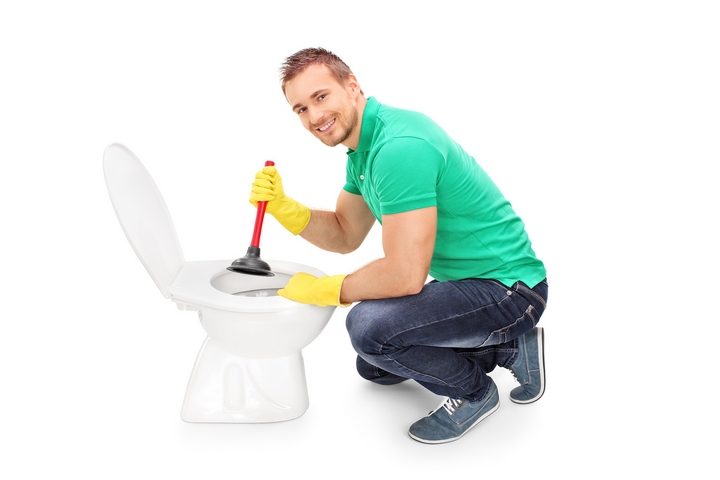Perfecting Plunger and Drain Cleaner: Essential Tips
Perfecting Plunger and Drain Cleaner: Essential Tips
Blog Article
What're your thoughts and feelings about How to Unclog Your Sink with a Plunger?

Introduction
Proper maintenance of house drains pipes is vital for avoiding obstructions and guaranteeing smooth water circulation. One of the trick tools in every house owner's toolkit is the plunger, along with various drain cleaners developed to tackle stubborn blockages successfully. This short article discovers exactly how to use bettors and drain cleansers effectively to maintain your drains streaming openly.
Section 1: Recognizing Plungers
Kinds of Plungers
There are numerous types of bettors readily available, each developed for various sorts of drains and blocks. One of the most usual kinds include cup plungers, flange bettors, and accordion bettors.
Just How Plungers Work
Plungers deal with the principle of producing stress and suction to displace obstructions. When properly applied over a drain, they create a vacuum that can pull out particles or separate clogs.
Picking the Right Bettor
Picking the appropriate bettor depends upon the kind of drain and the nature of the clog. Cup bettors are ideal for sinks and bathtubs, while flange bettors are better suited for commodes as a result of their style.
Typical Mistakes with Bettors
Preventing these mistakes ensures reliable plunging: incorrect seal around the drain, not enough pressure, and not clearing bordering debris.
Section 2: Utilizing Plungers Successfully
Prep work
Prior to diving, make sure the bettor covers the drainpipe entirely and develops a limited seal. Clear any type of visible particles around the drainpipe opening.
Method
Start with mild diving motions to construct suction. Boost pressure gradually, making use of a stable rhythm. Repeat as necessary till the drain gets rid of.
Fixing Tips
If diving doesn't function, try readjusting the seal, applying oil jelly for a much better seal, or making use of a different kind of bettor.
Section 3: Recognizing Drain Cleansers
Sorts Of Drain Cleansers
Drain pipes cleansers can be chemical or enzymatic. Chemical cleaners utilize solid chemicals to liquify blockages, while enzymatic cleaners use natural enzymes to break down raw material.
Just How Drainpipe Cleansers Work
Chemical cleaners respond with obstructions to liquify them, while enzymatic cleaners break down natural materials like hair and grease without damaging pipelines.
Security Considerations
Constantly use gloves and eye defense when utilizing chemical drain cleansers. Guarantee ample air flow and follow maker guidelines carefully.
Eco-Friendly Alternatives
Take into consideration making use of vinegar and baking soda or enzyme-based cleansers for eco-friendly options that are safer for pipelines and the atmosphere.
Area 4: Utilizing Drain Cleaning Company Efficiently
Application Strategies
Pour chemical cleansers directly right into the drainpipe opening. Enable them to benefit the recommended time before purging with hot water. Enzymatic cleansers need to sit over night.
Preventative measures
Avoid mixing various sorts of cleansers, as this can produce harmful fumes. Never ever make use of chemical cleansers in conjunction with a plunger, as splashing can happen.
Managing Persistent Blockages
For consistent clogs, take into consideration using a pipes serpent or calling a professional plumbing professional to stop damage to pipes.
Conclusion
Finally, comprehending exactly how to use bettors and drain cleaners properly is crucial for preserving healthy pipes systems. By selecting the right devices and methods, homeowners can take on minor obstructions and avoid significant plumbing concerns down the line.
How to Use a Plunger to Unclog a Drain
The humble plunger is a simple yet effective tool for breaking clogs in sinks, tubs and toilets. This handy tool is easy to use. You can make the most of its power if you understand how it works. Ready to dive in? Here’s what you need to know.
Safety First!
Never use a plunger with drain chemicals. Water will splash as you work, and the chemicals can spatter, burning skin and eyes. It’s a good idea to use rubber gloves and wear safety goggles when you work on a clog.
Choose the Right Tool for the Job
Plungers come in two different styles. Sinks, bathtubs and showers require a cup plunger. Like its name suggests, the rubber end is shaped like a cup. Use a flange plunger on toilets. These plungers have a rubber funnel extending from the cup. A plunger needs to be big enough to cover the drain.
Ready, Set, Plunge!
Coat the rim: Coat the plunger rim with petroleum jelly. This helps make a better seal.
Block outlets: Hold a wet rag over nearby outlets such as the overflow vent or the drain in a second sink.
Release air: Insert the plunger at an angle into the water. Water will displace air in the cup. A water-filled cup is more forceful than one filled with air.
Keep the plunger upright: Hold the plunger perpendicular to the drain. Use fast, forceful strokes, but make the first stroke gentle. The first stroke can create a splash if the cup still contains air. Thrust the plunger 15 to 20 times.
Snap off the plunger: The final stroke should be a strong upward motion that ends when the plunger snaps off the drain.
Repeat the process: you may need to repeat this sequence several times. When the water drains away, your work is done. High-five! https://plumbernw.com/blog/how-to-use-a-plunger-to-unclog-a-drain/

Application Strategies
Pour chemical cleansers directly right into the drainpipe opening. Enable them to benefit the recommended time before purging with hot water. Enzymatic cleansers need to sit over night.
Preventative measures
Avoid mixing various sorts of cleansers, as this can produce harmful fumes. Never ever make use of chemical cleansers in conjunction with a plunger, as splashing can happen.
Managing Persistent Blockages
For consistent clogs, take into consideration using a pipes serpent or calling a professional plumbing professional to stop damage to pipes.
Conclusion
Finally, comprehending exactly how to use bettors and drain cleaners properly is crucial for preserving healthy pipes systems. By selecting the right devices and methods, homeowners can take on minor obstructions and avoid significant plumbing concerns down the line.
How to Use a Plunger to Unclog a Drain
The humble plunger is a simple yet effective tool for breaking clogs in sinks, tubs and toilets. This handy tool is easy to use. You can make the most of its power if you understand how it works. Ready to dive in? Here’s what you need to know.
Safety First!
Never use a plunger with drain chemicals. Water will splash as you work, and the chemicals can spatter, burning skin and eyes. It’s a good idea to use rubber gloves and wear safety goggles when you work on a clog.
Choose the Right Tool for the Job
Plungers come in two different styles. Sinks, bathtubs and showers require a cup plunger. Like its name suggests, the rubber end is shaped like a cup. Use a flange plunger on toilets. These plungers have a rubber funnel extending from the cup. A plunger needs to be big enough to cover the drain.
Ready, Set, Plunge!
Coat the rim: Coat the plunger rim with petroleum jelly. This helps make a better seal. Block outlets: Hold a wet rag over nearby outlets such as the overflow vent or the drain in a second sink. Release air: Insert the plunger at an angle into the water. Water will displace air in the cup. A water-filled cup is more forceful than one filled with air. Keep the plunger upright: Hold the plunger perpendicular to the drain. Use fast, forceful strokes, but make the first stroke gentle. The first stroke can create a splash if the cup still contains air. Thrust the plunger 15 to 20 times. Snap off the plunger: The final stroke should be a strong upward motion that ends when the plunger snaps off the drain. Repeat the process: you may need to repeat this sequence several times. When the water drains away, your work is done. High-five! https://plumbernw.com/blog/how-to-use-a-plunger-to-unclog-a-drain/

I'm very fascinated with and I'm hoping you liked my article. So long as you enjoyed reading our page please consider to pass it around. We value reading our article about How To Use Your Toilet Plunger Correctly in 5 Easy Steps.
Book Service Report this page